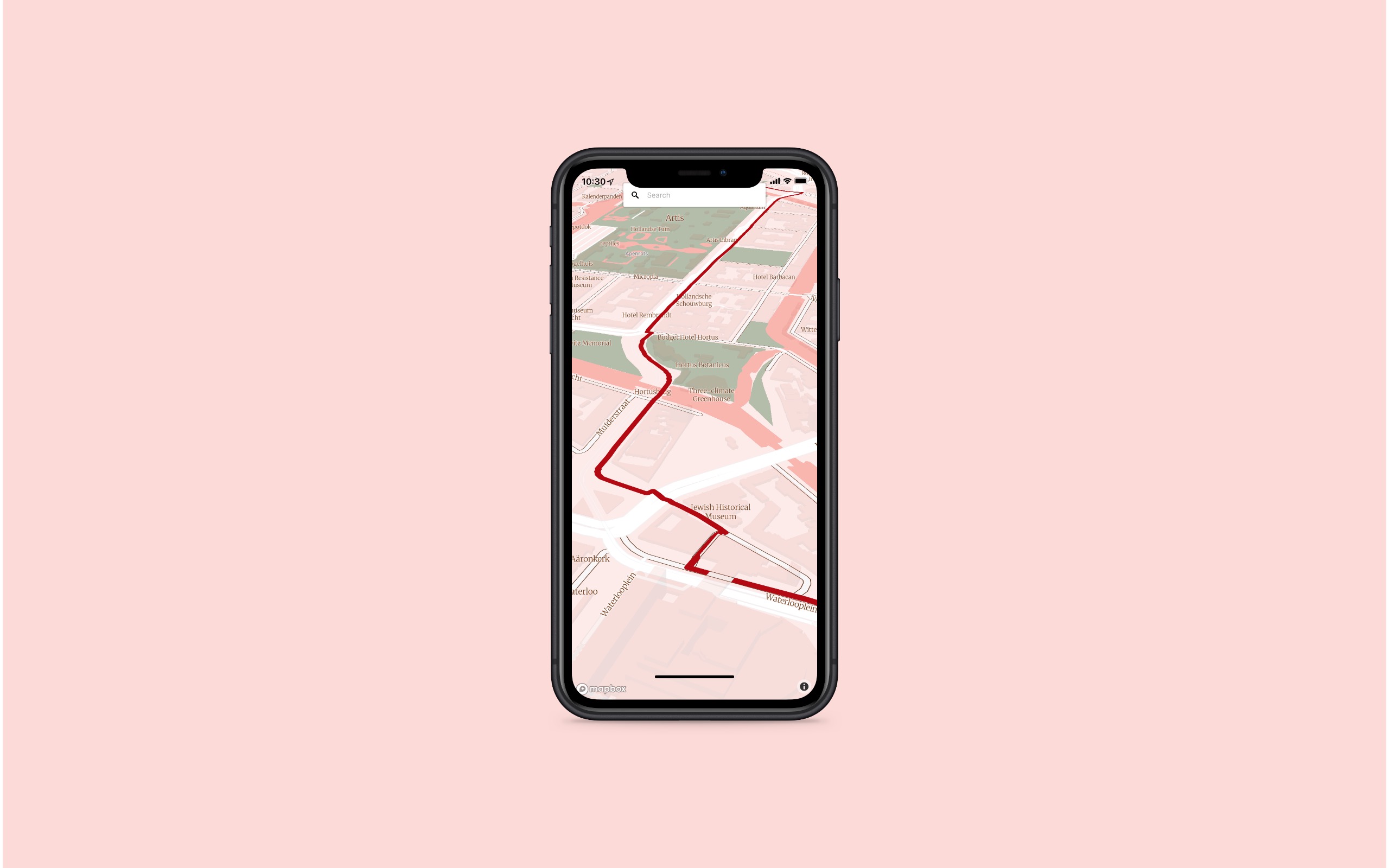Software and products

Prototyping with Framer using Mapbox APIs
Location
Melbourne, Australia
People
Matt Malishev
Tasks
- Build a geolocation mapping prototype in Framer for a mobile device
- Use Mapbox APIs to link data, tilesets, and styles from Mapbox Studio for the design
Outcomes
I’ve been meaning to dive into Framer ever since I watched a webinar a few months ago. It’s really fun and intuitive. You can integrate Mapbox’s features and preload data using imported tilesets, then prototype the interface in Framer.
As a toy project, here are biking directions from Framer HQ (I think) in Amsterdam to my favourite brewery Brouwerij ‘t IJ.
Click for interactive mobile prototype

If you’re unfamiliar with Framer, it’s a prototyping tool. Tons of features, interactions, device platforms, graphics, and icon sets.
Here’s the process for this project.
- Import the geolocation KML data and create a tileset in Mapbox Studio
- Design the map in Mapbox Studio
- In Framer, link the Mapbox API and apply features from the Mapbox components package, such as
SequentialLocationMap - Design the interface, including layout, buttons, transitions, icons, and colour palettes, in Framer using any device/media interface as a template
- Share the project with collaborators
Mobile
One cool aspect is you can open the prototype on your own mobile and use regular gestures to navigate the interface.




From here, it’s pretty simple to switch to different device skins, as well as integrate a newly created design and palette from Mapbox Studio.


Tools
Framer
Mapbox
Links
Interactive trivia site for the Netflix series DARK
Location
Melbourne, Australia
People
Matt Malishev
Nicole Malishev
Tasks
- Make an online and interactive trivia quiz for the Netflix series DARK
Outcomes
A trivia quiz spanning all three seasons of the Netflix series Dark. The idea first started as a piece of paper job to test one of our brothers and his friends. Since they were taking it remotely online, we decided to make it into a website.
My sister Nic and I devised the questions, while she came up with the design and I coded it.
WARNING: Spoiler alert
If you haven’t yet seen the series, I highly recommend it.
Take the DARK trivia

R Coding Club for teaching coding, data analysis, and research tools
Location
Emory University
Atlanta, USA
People
Matt Malishev, Emory University, USA
Desiree de Leon, Emory University, USA
Hasse Walum, Emory University, USA
Tasks
- Developed and maintained a regular coding club in coding, research tools, and data analysis in
R - Developed take-home, reproducible coding modules for unsupervised learning
Outcomes
- Monthly coding club in
Rat Emory University - Teaching and mentoring from undergraduate to professor levels
Example outputs
Head directly to the Emory Coding Club website to see all info on session material and lesson modules.
R Coding Club website

Individual-based model of closed predator-prey system using game theory rules with full energy and mass conservation
Location
Vrije Universiteit
Amsterdam, The Netherlands
People
Matt Malishev, Centre of Excellence for Biosecurity Risk Analysis, Australia
Bob W. Kooi, Vrije Universiteit, Amsterdam, The Netherlands
Sebastiaan A.L.M. Kooijman, Vrije Universiteit, Amsterdam, The Netherlands
Tasks
- Developed a metabolic theory-driven individual-based model for hawk (predator) and dove (prey) game theory dynamics in a stochastic predator-prey model. The model integrates individual-level bioenergetics of each trophic level with full energy and mass conservation, i.e. a closed system.
- Used replicator dynamics to link behavioural states among individuals in the payoff matrix (fast time scale) and an evolutionary stable strategy at the population and community levels (slow time scale).
Select trait
Hawk (p)
Dove (1 – p)
Abilities
Dove
Always share prey with another dove.
Hawk
Always beat dove
If competing with a hawk, you incur a cost, C, and a 0.5 probability of gaining prey, G.
Controls on the fast time scale
Searching
Handling
Fighting
Outcomes
- Malishev M, Kooi BW & Kooijman SALM (2013) Individual-based modelling of a predator’s hawk-dove strategy in a closed bottle (poster), EcoTas13, Auckland, New Zealand

References
Kooijman, S. A. L. M., Grasman, J. & Kooi, B. W. (2007) A new class of non linear stochastic population models with mass conservation. Mathematical Biosciences, 210:378–394.
Auger P, Kooi BW, Bravo de la Parra, R & Poggiale, JC (2006) Bifurcation analysis of a predator- prey model with predators using hawk and dove tactics. Journal of Theoretical Biology, 238:597–607.
Kooijman, SALM (2010) Dynamic Energy Budget theory for metabolic organization, Cambridge University Press, Cambridge.
Holling, CS (1959) Some characteristics of simple types of predation and parasitism. Canadian Entomologist, 91:395–398.
van der Meer, J (2006) An introduction to Dynamic Energy Budget (DEB) models with special emphasis on parameter estimation. Journal of Sea Research, 56:85–102.
Kooi, BW (2015) Modelling the dynamics of traits involved in fighting-predators–prey system, Journal of Mathematical Biology, 71: 1575–1605.
Download the full poster (MalishevKooiKooijman_EcoTas13_poster.pdf).
Header image: Taking advantage of open source data to understand plot mechanics in R.
| Back to top | Home page |